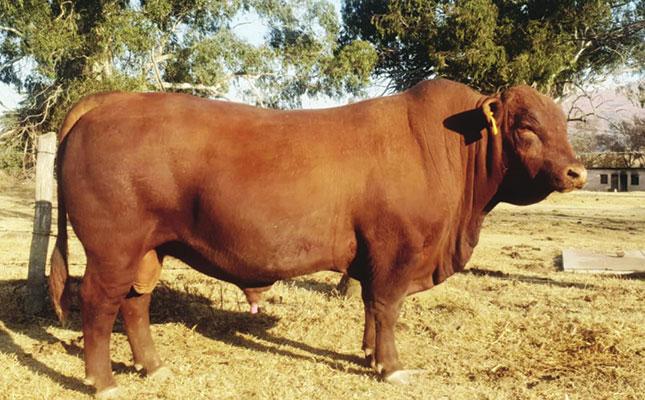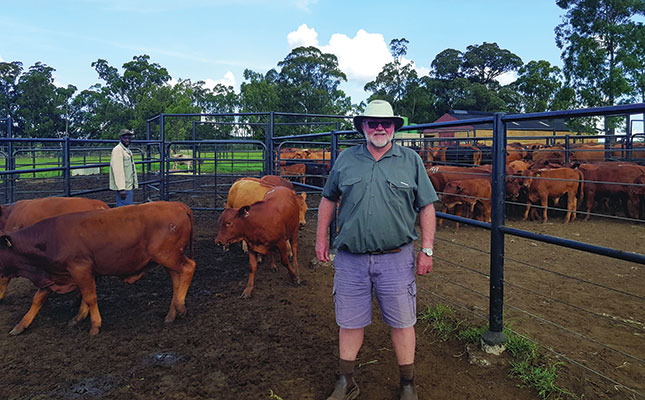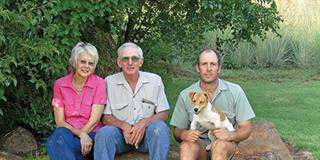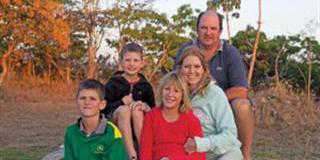
Photo: Lindi Botha
Rian van Wyk, owner of Jagtdrift Brangus in the Panbult area of Mpumalanga, has built his business on well-adapted, early-maturing cows that consistently produce sought-after weaners.
He attributes much of his success to choosing a breed with favourable characteristics that centre on fertility, maternal ability and satisfactory weight gain, whether on the veld or in a feedlot.
Brangus cattle were introduced to Jagtdrift 24 years ago along with bulls of four other breeds. Over the years, however, the Brangus female animals outperformed the others in terms of fertility and maternal abilities, and today the herd is almost wholly Brangus. Van Wyk’s goal is for the entire herd to comprise purebred Brangus within the next two years.
The Jagtdrift Brangus herd consists of 900 breeding cows and a stud component for breeding superior bulls. By using Brangus, Van Wyk has reduced cow mortalities and improved weaning rates due to the breed’s smaller calving weights.
“Calving problems are a significant contributing factor to cow mortalities, and consequently lower weaning rates. I make the birthing process easier by breeding for smaller heifer calves that average 33kg, and bull calves that average 35kg,” he says.
He emphasises that a cattle farmer’s success rate is largely determined by the number of calves weaned. “Our total weaning percentage is about 76%. This includes mortalities, stock theft and anything else that prevents a weaner from getting to market, because conception rates mean nothing if there are no weaners.”

While smaller calves generally mean smaller weaners and smaller mature animals, Van Wyk relies on ‘curve-bender’ bulls to improve weight gain. “If you measure the performance of cattle on a graph, there should be a straight line that runs from the bottom left-hand corner to the top right-hand corner as the animal ages and picks up weight,” he explains.
“It’s therefore [obvious] that a bigger calf will be heavier at 200 days, and then at 400 days, than a smaller calf, as the birthweight projects what the mature weight will be. So if you breed for smaller calves, a smaller animal will go to the feedlot at 400 days, which [reduces] your income.
“But if you have a curve-bender Brangus bull, while his progeny are inclined to produce small calves, these calves gain a substantial amount of weight as they mature, providing an upward curve on the growth graph. So you have the advantage of easier birthing for the cows, while still achieving good weaning weights and good weight gain in the feedlot, which means they’ll be in high demand.”
Fewer than 10% of cattle have the genetics to ensure curve benders, which is why it took Van Wyk three years to find the right bull. Aptly, he named him ‘Curve Bender’, and uses him as a stud sire to boost this trait in the herd.
To shorten the selection period, Van Wyk uses genomic testing to determine whether a bull calf has the desired genetic make-up of his parents. This means that rather than having to wait for the bull calf to grow and prove his performance over time, a DNA test can be conducted soon after birth to determine which of the genetic markers of his parents he carries. Such a calf can therefore be used or sold with his full value in mind from the start.
Fertility and breeding
Four of the costliest failures a cattle farmer can experience are reproduction losses when cows don’t calve, mortality, a lack of growth, and stock theft. Van Wyk therefore emphasises that a producer should never skimp on animal health, genetics, nutrition and good fencing.
With regard to higher conception rates, he notes that bull selection is key.
“Choose bulls according to their maternal records and performance test results,” he says.
“This will guide you in terms of the genotype.Phenotypically, early-maturing bulls will have shorter legs, specifically a shorter cannon bone, which is the bone between the knee and the hoof. The diameter of the scrotum goes hand-in-hand with sexual maturity, with a larger diameter indicating earlier maturity.
“Once the animal has reached sexual maturity, there’s also a change in hair colour and quality. A male’s midsection must be lighter than its neck and back end. The obvious darkening of the neck is a sign of sexual maturity.”
Breeding cows should be selected to calve early, and definitely before they are 39 months old. This is the cut- off date in an extensive system; thereafter a cow is considered infertile. Ideally, the calving age should be 30 months. Cows are also selected for functional udders and teats, so that calves can drink from day one without someone having to milk the cows first.
Nutrition plays a major role in fertility, and Van Wyk’s feeding programme results in heifers that can be mated earlier. The farm has a maize and soya bean crop component and, in addition to having access to sourveld, the cattle are allowed to graze on the residue here in the winter months, when the grass is unpalatable.
When the soya bean is harvested in March, a 60ha area is planted to oats. This produces protein- and vitamin-rich grazing, which can be grazed from June. The animals with the highest feeding requirement, such as heifers calving for the first time, are placed on these fields to graze.
This high-quality grazing means that heifers don’t lose condition while in calf, explains Van Wyk. It also ensures that they obtain enough protein and other nutrients to ensure physiological maturity while still feeding their calves.
“If heifers are mated too soon (younger than 30 months), they run the risk of inhibiting their own growth, as milk production takes a lot of protein and minerals from the body. If you want them to conceive again in three months, they need to be in top condition.”
Van Wyk follows a breeding programme that enables cows to calve at the same time every year. This prevents the calving date from shifting to the point where the cows eventually skip a year.
“You can’t achieve this if you don’t have the right feeding programme. If I relied only on veld grazing, for example, this wouldn’t be possible.”
Jagtdrift’s breeding season falls slightly later than the norm for the area. Van Wyk aims for calving from December to mid-February, as this is when the farm’s grazing is at its best.
Feeding is the greatest expense for a beef cattle farmer, and it can be particularly costly when there is insufficient natural grazing available.
Jagtdrift has a carrying capacity of 1 MLU/2ha, a figure which takes summer grazing into account, as in winter the cattle graze mostly crop residue and hay produced on the farm.
Van Wyk aims to wean his heifers at around 200kg and bull calves at 205kg. For his commercial herd, a good season normally results in these animals achieving 225kg and 235kg respectively.
Improving genetics
Jagtdrift has a registered Brangus stud, which supplies the commercial herd with top genetics.
“The only way to improve [on] your cows is with better bulls. If your calves have more growth and genetic potential than their dams, then you know you’ve succeeded. I aim to ensure that at least 60% of my calves each season are an improvement on the previous generation. The higher this percentage, the faster I can advance.”
Breeding his own bulls puts Van Wyk at an advantage, as these animals are already adapted to the farm, whereas animals bought in run the risk of not adapting to their surroundings.
On average, 1 000 cows are mated annually, and of these, approximately 30% conceive via artificial insemination (AI). Some 20% of this AI is done with imported semen from bulls that Van Wyk deems to be the best in the world.
“The imported semen also aids in marketing, since genetics from the best bulls in the world are in high demand,” he says. “It’s also important to bring in genetics from an outside herd [outcrossing], as it gives a result that’s similar to heterosis.”
He also uses semen from his own top bulls. The remaining 70% of female animals are mated naturally, with several male and female animals placed in a camp together.
DNA testing on the calves determines which were the more successful bulls, and those that are the least effective are eventually culled.
Once weaned, the cattle spend six months on the veld and are then placed in the on-farm feedlot for about 140 days.
The top-performing bull calves are kept back and raised separately in order to undergo a selection process. The best 35 are sold or used to replace Jagtdrift’s herd bulls, while the rest are sold for slaughter.
Since cows generally have a lifespan of about nine years, Van Wyk aims to replace 100 cows each year. He keeps 300 heifers back, and after selecting those that will become replacement cows, breeds the remainder for sale as in-calf breeding heifers.
Cows at the end of their lifespan go into the feedlot with their calves. As these calves have not adjusted to the veld, they are sent to slaughter with the dams.
Jagtdrift sells animals at two production sales every year: the Mpumalanga Brangus Club Sale, and the Vleissentraal Ermelo Annual Sale.
Advice to young farmers
Van Wyk emphasises the importance of keeping clients in mind when it comes to breeding.
“Buyers, feedlots and butchers have different demands, and it’s crucial to adhere to these requirements if you want to sell your animals at a decent price. Keep your customers satisfied.”
His recommendation for farmers who are starting out is to focus on quality, and always strive to raise the bar of the herd.
“Breed with good female animals and buy the best bulls you can afford from an area that has similar diseases to those in your own area; bought-in bulls must be able to adapt. Get to know other breeders who will inspire you, and consult with experts on a regular basis.
“While purebred animals fetch higher prices than their crossbred counterparts, crossbreeding can add kilograms to your calves. However, [in the case of the latter], it’s important to only use terminal breeds such as Charolais or Limousin, so that their traits aren’t brought back into the herd.”
He also stresses the value of setting long- term goals and planning to achieve these outcomes.
“With the help of good advisers, draft and implement a family succession plan. Build and maintain a team of personnel who meet the set standard. These should include both cattle consultants and business experts.”
Email Rian van Wyk at [email protected].













